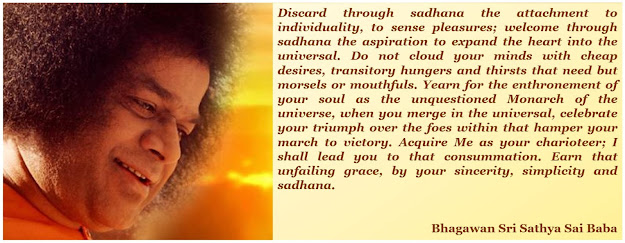In previous instruction, we dedicated all our actions to God.
Let us fully appreciate the value of dedicating
all actions, including desire filled actions, to God.
By doing so, at least he starts moving from
self-centeredness to selflessness, a big move indeed. We should not
underestimate the value of such a step.
There is no restriction to give up Kamya Karma in previous instruction. The
only condition is that it, too, has to be dedicated to God. This makes us
mindful of what kind of desires we permit in our mind. If we are going to offer
them as worship, we had better keep them clean!
Sadhakas may recall the “Kaye na vaacha” talk in which this was
clarified. If all the instruments of actions, the antahkarana, the gross body, the sanskaras, everything has to be offered to God, then, what should
be the quality of all these things to be worthy of being offered to God?!
In the current instruction, Kamya Karma is specifically targeted for restriction, renunciation
or better still, elimination. This may be very difficult for most people, but
it is absolutely necessary from the point of view of our training.
The question we ask ourselves is: “Can Kamya Karmas also be dedicated to
God?”
Apart from our daily duties and special
occasional duties, we are quite happily performing many other things simply
because we like them. We do not have to do them, but we do them only because of
a personal preference for them. These classify under Kamya Karmas.
Our eating habits are almost exclusively our own
choice. We don’t really eat out of a sense of duty, but because we enjoy food.
That makes it a Kamya Karma.
We go in for the best foods we can afford. The
choice depends on our taste and affordability. We may have an expensive taste,
but that is beside the point. As far as the scope of dedicating all action to
God as per previous instruction, we are permitted whatever we like to eat
and drink, as long as we place some on our altar for God as well!
Now in the current instruction, we apply the
brakes on Desires. Our aim is to introduce Desirelessness into our lives. It is
quite logical. Hence, Kamya Karma is
put under the spotlight, as it were.
We are required to do something about it.
When we apply brakes in a moving car, the car
does not stop at once. It takes a while before it comes to a standstill. So it
is with applying brakes on actions, and even more so on applying brakes to
desires. We cannot give up our actions all at once, much less give up desire
all at once. It is a slow, painstaking process, as we shall soon see.
The spirit of Sadhana Panchakam is not to impose rules to dictate our life. That
is not the aim of current step or any other step in Sadhana (40 steps/40 instructions).
We cannot renounce desires just by imposing a
rule on ourselves. Resolutions can assist us to change, but in themselves they
do not produce change.
We need to spiritually evolve ourselves out of
Desire. Spiritual progress cannot come through regimentation, but only through
deep intellectual conviction based on deeper knowledge and experience.
Through inner conviction alone can we succeed in
this life-long struggle to check on our desires.
Renunciation comes in the wake of personal
experience we gain in seeing desires for what they are. Experience in life
teaches us that there is no end to desires, no matter how much we satisfy them.
The same Vedas which gave their
consent to certain Kamya Karma at an
early stage in our growth through the Karma
Kanda and Upasana Kanda, also
point the way to its renunciation later on in the Jnana Kanda. It expects us to grow out of Desire gradually.
The Acharya
at the Gurukula imposes certain
limits, but he knows full well that all are not going to become Sannyasis. (In
the case of instructions/satsangh/sessions given by the author to few select
aspirants, he also knows the limitation/level of each aspirant as to how much
they can really follow.)
In the beginning the instruction permits some
laxity. Later, one can make it as stringent as one likes. The bar of Sadhana gets raised as we progress in Sadhana.
Sankara is not saying, “Renounce Kamya Karma”,
He is saying, “Renounce all desires in the mind,” i.e. renounce Kama!
The abandonment of the desire-prompted actions
must be accompanied by the abandonment of the desires themselves in the mind.
So we see that there is a lot of depth in this Step in Sadhana. When we grasp the full implication of this Step, we see
that it calls for a major change in our mental disposition towards objects
outside.
The task is a mammoth one, and calls for every
ounce of determination we can muster in our mind and our will.
This Step, when inculcated at an early age,
reaps dividends later in life. It calls for patience and perseverance. No
effort is wasted. Effort has to be sustained to avoid stagnation. As we
progress in other Sadhanas, this one Sadhana goes on in parallel to the very
end of our spiritual journey. In fact, it is the single true measure of our
spiritual progress. It determines our overall progress in all the other steps
henceforth.
Sadhakas may recall that the
origin of Kama or desires, the
process flow of desires, the manifestation of desires to action, the
consequence of such actions in terms of fetching us new (red) arrows or fresh
karmas - all these things have been
most elaborately given through the Karma
and the Manas Buddhi Chitta Ahankara
sessions which are also available in youtube
for listening and introspecting at any point of time.
Love.



No comments:
Post a Comment